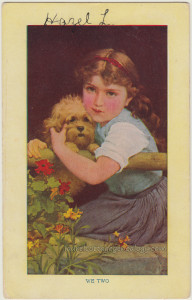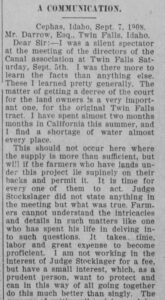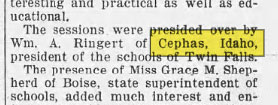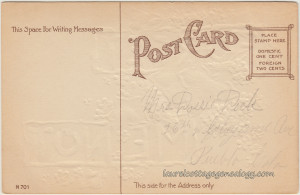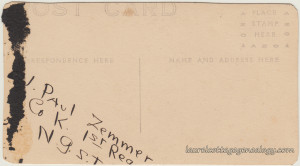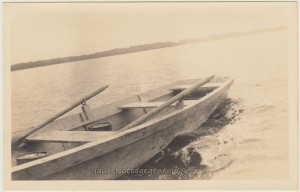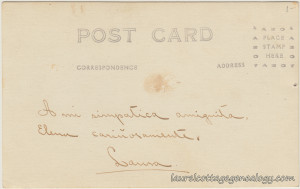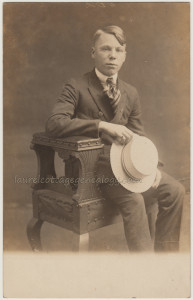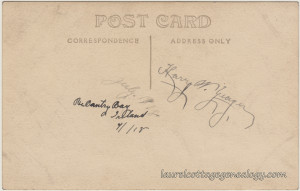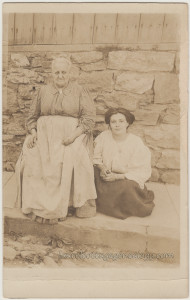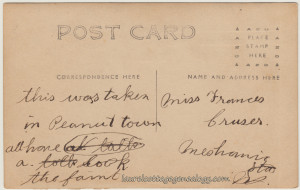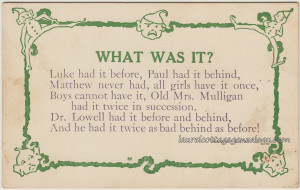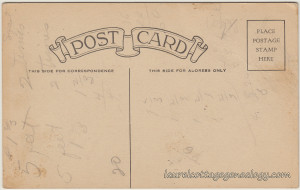Divided back, used postcard. Postmarked November 16, 1909 from Cephas, Twin Falls, Idaho. Publisher: Arthur Capper.
Price: $25.00
A rare postcard, postmarked from Cephas, Idaho.
True friends: A lovely rosy-cheeked little girl is hugging her dog; she is sitting on the ground and they are both leaning over a round wooden fence rail. In front of them are some orange and yellow flowers. The caption underneath says, “We Two” and at the top the sender has signed, “Hazel L.” The card is postmarked November 16, 1909 from Cephas, Idaho, and is addressed to: “Miss Bessie Ellison. 26th & Cheyenne. Pueblo Colo.”
The sender wrote, “Hello Bessie. Yours. Hazl. Twin Falls Ida.”
Cephas, Idaho
The town or post office station of Cephas, Idaho did not, at first, show up in online searches. Research indicated that it may have been connected or named after Cephas Lilly, a settler in 1890 of the town that would later become Castleford, Idaho, in Twin Falls County. Further research for Cephas Lilly reveals an appointment of an Idaho postmaster set of records, and shows that, at one time, Cephas Lilly was postmaster for a town[?] or perhaps just post office, listed as Cephas, in Twin Falls, Idaho. On this same appointment of postmaster record is listed the town of Castleford, so it appears that the two names denoted two separate places. The dates in question for Postmaster Lilly are October 22, 1907, (with a “c.” next to it) and September 30, 1911 (with “dis.” next to it.) I am not sure what the “c” stands for, but “dis.” is possibly for “discontinued.” There is a typewritten explanation at the beginning of this set of records which lists the recorded info as: the name of the post office, the date established, discontinuance, changes of name, state or county, and the occasional re-establishment of post offices. Since the 1909 postmarked date is later than the 1907 record date, maybe the online record is only showing partial information for the Cephus post office.
Updated as of February 14, 2024:
I had occasion to go back into this post and thought I’d do a little more digging. In checking Newspapers.com, Cephas, Idaho shows up in September 1908. Below, the partial article clipped from The Times-News, (Twin Falls, ID) having to do with a water and canal issue. The person, (D. T. Welty) was writing his or her letter from Cephas, on September 7, 1908:
The last reference found via Newspapers.com, for Cephas, Idaho is dated February 20, 1912:
Sources: Castleford, Idaho. http://en.wikipedia.org/wiki/Castleford,_Idaho (accessed February 14, 2024).
National Archives and Records Administration (NARA); Washington, D.C.; Record of Appointment of Postmasters, 1832-Sept. 30, 1971; Roll #: 26; Archive Publication #: M841.
“A Communication.” The Times-News (Twin Falls, ID). September 24, 1908. Thursday, p. 4. (Newspapers.com).
“School Trustees Are In Session.” The Times-News (Twin Falls, ID). February 20, 1912. Tuesday, p. 1. (Newspapers.com).

